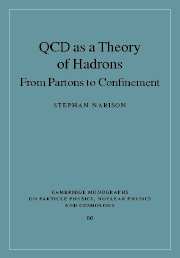Book contents
- Frontmatter
- Contents
- About Stephan Narison
- Outline of the book
- Preface
- Acknowledgements
- Part I General introduction
- Part II QCD gauge theory
- Part III MS-bar scheme for QCD and QED
- Part IV Deep inelastic scatterings at hadron colliders
- Part V Hard processes in e+e– collisions
- Part VI Summary of QCD tests and αs measurements
- Part VII Power corrections in QCD
- Part VIII QCD two-point functions
- Part IX QCD non-perturbative methods
- Part X QCD spectral sum rules
- 47 Introduction
- 48 Theoretical foundations
- 49 Survey of QCD spectral sum rules
- 50 Weinberg and DMO sum rules
- 51 The QCD coupling αs
- 52 The QCD condensates
- 53 Light and heavy quark masses, etc
- 54 Hadron spectroscopy
- 55 D, B and Bc exclusive weak decays
- 56 B0s-B̄0s Mixing, Kaon Cp Violation
- 57 Thermal behaviour of QCD
- 58 More on spectral sum rules
- Part XI Appendices
- Bibliography
- Index
47 - Introduction
from Part X - QCD spectral sum rules
- Frontmatter
- Contents
- About Stephan Narison
- Outline of the book
- Preface
- Acknowledgements
- Part I General introduction
- Part II QCD gauge theory
- Part III MS-bar scheme for QCD and QED
- Part IV Deep inelastic scatterings at hadron colliders
- Part V Hard processes in e+e– collisions
- Part VI Summary of QCD tests and αs measurements
- Part VII Power corrections in QCD
- Part VIII QCD two-point functions
- Part IX QCD non-perturbative methods
- Part X QCD spectral sum rules
- 47 Introduction
- 48 Theoretical foundations
- 49 Survey of QCD spectral sum rules
- 50 Weinberg and DMO sum rules
- 51 The QCD coupling αs
- 52 The QCD condensates
- 53 Light and heavy quark masses, etc
- 54 Hadron spectroscopy
- 55 D, B and Bc exclusive weak decays
- 56 B0s-B̄0s Mixing, Kaon Cp Violation
- 57 Thermal behaviour of QCD
- 58 More on spectral sum rules
- Part XI Appendices
- Bibliography
- Index
Summary
We have discussed in the previous part several of the most popular QCD non-perturbative methods other than the QCD spectral sum rules (QSSR). Now, we shall dedicate this part of the book to the discussion of this non-perturbative approach, which has been used successfully for understanding the hadron properties and hadronic matrix elements, using those parameters (QCD coupling, quark masses and QCD condensates), derived from QCD first principles. This method was introduced by SVZ in 1979 [1] and reviewed in a book [3], numerous reviews and lecture notes [356–365]. Its basic concepts, based on the operator product expansion and dispersion relations, are well understood in quantum field theory, and is a fully relativistic approach in contrast to potential models, for example. Its applications are quite simple and transparent. However, on the one hand it has a limited accuracy (usually about 10–20% depending on the process), and some uses of the method in some QCD-like models show that its accuracy cannot be improved iteratively. On the other hand, confinement is not a result of the method but is put into it via the introduction of different QCD condensates. In practice, one has to introduce some assumptions, and the results are obtained from self-consistency.
However, in some cases, results obtained from the sum rules disagree with each other and have led to some polemics, which some people use to discredit the approach.
- Type
- Chapter
- Information
- QCD as a Theory of HadronsFrom Partons to Confinement, pp. 489 - 490Publisher: Cambridge University PressPrint publication year: 2004



